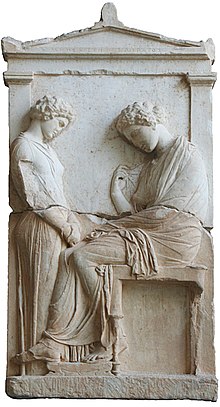
Back العبودية لدى الإغريق Arabic Esclavitud a l'antiga Grècia Catalan Sklaverei im antiken Griechenland German Δουλεία στην αρχαία Ελλάδα Greek Esclavitud en la Antigua Grecia Spanish Esklabotza Antzinako Grezian Basque Esclavage en Grèce antique French Escravitude na Grecia antiga Galician עבדות ביוון העתיקה HE Ropstvo u staroj Grčkoj Croatian

This article needs additional citations for verification. (October 2023) |
Slavery was a widely accepted practice in ancient Greece, as it was in contemporaneous societies.[2] The principal use of slaves was in agriculture, but they were also used in stone quarries or mines, and as domestic servants.[3]
Modern historiographical practice distinguishes between chattel slavery (where the slave was regarded as a piece of property, as opposed to a member of human society) and land-bonded groups such as the penestae of Thessaly or the Spartan helots, who were more like medieval serfs (an enhancement to real estate).[4] The chattel slave is an individual deprived of liberty and forced to submit to an owner, who may buy, sell, or lease them like any other chattel.[5]
The academic study of slavery in ancient Greece is beset by significant methodological problems.[6] Documentation is disjointed and very fragmented, focusing primarily on the city-state of Athens. No treatises are specifically devoted to the subject, and jurisprudence was interested in slavery only as much as it provided a source of revenue. Greek comedies and tragedies represented stereotypes, while iconography made no substantial differentiation between slaves and craftsmen.[7]
- ^ A traditional pose in funerary steles, see for instance Felix M. Wassermann, "Serenity and Repose: Life and Death on Attic Tombstones" The Classical Journal, Vol. 64, No. 5, p.198.
- ^ Polakoff, Murray E.; Dhrymes, Phoebus J. (1958). "The Economic and Sociological Significance of Debt Bondage and Detribalization in Ancient Greece". Economic Development and Cultural Change. 6 (2): 88–108. doi:10.1086/449759. ISSN 0013-0079. JSTOR 1151738. S2CID 154209570.
- ^ Morris, Sarah P.; Papadopoulos, John K. (2005). "Greek Towers and Slaves: An Archaeology of Exploitation". American Journal of Archaeology. 109 (2): 155–225. doi:10.3764/aja.109.2.155. ISSN 0002-9114. JSTOR 40024509. S2CID 147684885.
- ^ Hunt, Peter (2016-12-19). "Slaves or Serfs?: Patterson on the Thetes and Helots of Ancient Greece". On Human Bondage. pp. 55–80. doi:10.1002/9781119162544.ch3. ISBN 9781119162483.
- ^ "Modern Day Abolition – National Underground Railroad Freedom Center". freedomcenter.org. Retrieved 2023-03-12.
- ^ Hunt, Peter (2017). Ancient Greek and Roman slavery. John Wiley & Sons, Incorporated. ISBN 978-1-78785-697-4. OCLC 1176434948.
- ^ "Review of: Reconstructing the Slave: the Image of the Slave in Ancient Greece". Bryn Mawr Classical Review. ISSN 1055-7660.
© MMXXIII Rich X Search. We shall prevail. All rights reserved. Rich X Search